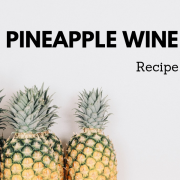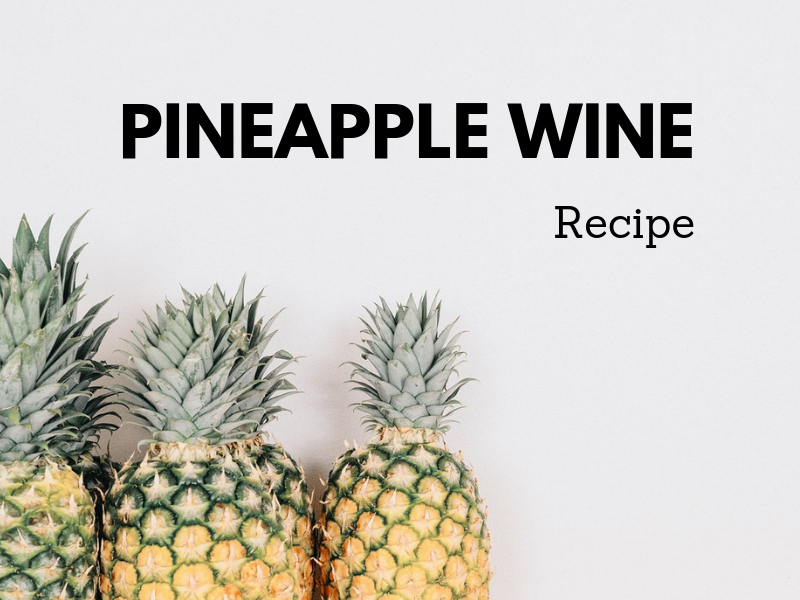Pineapple Wine Recipe – Tropical Tasting Wine
Pineapple is a tropical fruit but even so, it is available year-round in many places, either fresh or in cans so it makes a great wine to make when other fruits are out of season. It’s great for bringing a tropical shine to even the coldest weather when not much else is growing.
Table of Contents
You’ve Never Heard Of Pineapple Wine?
Pineapple wine may not be that common compared to other fruit wines. In countries like Hawaii and other tropical countries where pineapples grow, making alcohol with pineapples is quite commonplace.
Pineapples are one of the sweetest fruits around and this high sugar level is perfect for winemaking. The flavour and natural acidity of the pineapple come through in the finished wine, reminiscent of a pineapple flavoured Sauvignon Blanc.
Fresh Or Canned Pineapple?
This pineapple wine recipe works with both fresh or canned pineapple so the odds are that if there are no fresh pineapples available near you can still make this pineapple wine. It makes this wine a real year-round possibility.
I would usually recommend fresh if available as you can choose the fruit yourself and test how ripe it is but really you probably wouldn’t be able to tell the difference between canned pineapple wine or fresh.
Picking The Best Fresh Pineapples
If you use fresh pineapple for this recipe then taking the time to pick out ripe pineapples will make a lot of difference to the finished wine.
You want ripe pineapples, you can tell as the leaves can be easily pulled from the crown with a short tug. Under-ripe pineapples have less sweetness and are slightly tarter but are better to use than over-ripe pineapples.
Over-ripe pineapples should be avoided. You will notice the surface of the fruit will have a grey powderiness and it is quite possible the pineapple is already fermenting so avoid this at all costs.
Building Body In the Pineapple Wine
Pineapple wine needs a little help to retain the flavour and body you would expect from such a full flavoured fruit. After fermentation, the wine can be a little thin so we need to boost the body and bolster the flavour.
Adding raisins to the must give the finished wine more body and the wine will have a sweeter quality so the pineapple flavour can really shine.
What You’ll Need To Make Pineapple Wine – Makes 1 gallon / 4.5 litres
- Large Stock Pot
- Small Fermenting Bucket
- Demijohn
- Syphon
- Fine Straining Bag
- Potato Masher
- Airlock & Bung
Pineapple Wine Ingredients
- 1.8kg Pineapple (fresh or canned)
- 4 litres Water
- 800g Sugar
- 120g Golden Raisins
- 1/4 tsp Wine Tannin
- 1/4 tsp Acid Blend
- 1/2 tsp Pectic Enzyme
- 1 tsp Yeast Nutrient
- 1 Campden Tablet
- 1 Sachet Yeast (Lalvin D-47 is a good choice but experiment with others)
Pineapple Wine Method
1. Prepare the pineapple by cutting the top and the skin from the flesh. Cut the flesh away from the core into small thumb sized pieces.
2. Chop the golden raising roughly and add these along with the pineapple to the straining bag. Set the staining bag with the fruit and the raisins into a sanitised fermenting vessel and ensure the top of the bag is secured.
3. In a large pan heat half the water and slowly add the sugar to dissolve. Bring the pan up to a boil and ensure all the sugar is stirred in to prevent scorching. Once boiling simmer for a few minutes.
4. Remove the sugar solution from the heat and pour over the pineapple and raisins in the straining bag. Give everything a gentle stir around. Top up the fermenter with the remaining cool water and allow to cool to room temperature before adding a Campden tablet.
5. 12 hours after adding the Campden tablet, add the yeast nutrient, tannin, pectic enzyme and acid blend and stir gently to incorporate. Leave the must for 24 hours.
6. The following day, add the yeast by sprinkling onto the surface of the must (you can rehydrate the yeast according to the packet instructions for best results). Cover the vessel and fit an airlock and allow to ferment.
7. Stir the fermenter gently every day to ensure the pineapple gets fully broken down. After 10 days fermentation should have begun to slow or stopped remove the straining bag with pulp and allow to drip dry and discard. Cover the fermenting vessel and allow to settle.
8. The following day rack the pineapple wine to a demijohn / carboy for clearing and conditioning. Fit the demijohn with a bung and airlock. A hydrometer reading will inform you that the wine has reached finishing gravity, around 1.000 +/- 0.003.
9. Over several weeks or months, the wine will clear. After a month or so some sediment will have built up, rack to a clean demijohn and allow to condition. Repeat this procedure when any substantial sediment has begun to settle.
10. After at least 3 – 4 months you can think about bottling the wine. The pineapple wine will improve with ageing so leaving the wine in the demijohn up to 6 – 8 months is perfectly fine.
When bottling the wine you can consider back sweetening and stabilising. Sample the wine if you would prefer a sweeter finish then follow the instructions here.
This pineapple wine is best aged in the bottle for upto 6 months before sampling. The longer you leave the wine the better as it will continue to improve with time.





In Nigeria which is nota wine producing country, wine yeast could be difficult to come by. But bread yeast or bakers yeast is very available. Can one experiment with this?
Nigeria is a high pineapple producing nation, but most of it are eating as fruits and drank as juice. Can the pineapple wine starter yeast be bought from producers or stockers outside of the country?
Hi, brewing yeast(Alcohol) is the idea one for making pineapple wine,you can easily buy from Amazon or other sites online.
”Tepache” is a traditional MEXICAN driink that uses Pineapple skins with the addition of a l,ocal DARK SUGAR though I use ordinary Muscavado. It’s supposed to,be low alcohol but of course the ABV depends on how much sugar you add . Mine has always truned out considerably MORE than Low Alcohol Some recipes use the whole Pineapple. The impoortant part of TEPACHE is that it’s the naturally occuring yeast on the skin that facilitates the fermentation I cannot see why you cannot first kill off the natural yeast and then use normal wine or cider yeast. I think that using the skins natural yeast can be a bit hit or miss though mine has turned out OK up to now.
Wow! Its very usefull recipe for me, I tried 1 day back.. now added yeast and frementation started, Thank you so much
No problem. Hope it turns out great.
How to back sweet the pineapple wine is the best?
These instructions will explain how to back sweeten the wine.
About 18 months ago a local grocery store had pineapples for sale for $.99 each. No limit. I ended up buying 49 pineapples. I used a juicer that seperated the pulp from the juice. I got 8 gallons of pure juice. I corked 6 and capped 2. I had gone in the basement for about 6 min preparing to begin making the wine ang one of the jugs EXPLODED BEWARE HIGH YEAST !!!!!!!
So you got approx 40 litres of juice from 49 fruit? I’d say that’s a bit of an oversetimate. No yeast ferments so quickly as to explode a bottle in six minutes either irrespective of just why you would cork it tight enough to do so in the first place. All yeats suffer a ‘fermentation ‘shock’ when added to the brew and do not start immediately. That’s why some people always ‘start’ their yeast externally though myself I never bother to. Sure you know how to use an air lock.
Hi. will deffo give this a go! what sort of abv% are we looking at from this recipe?
How much is one sachet of yeast in this recipe? 5 g?
Yes, 5g. Wine yeasts that come in 5g sachets are typically enough to ferment upto 20 – 25 litres of wine.
It does not really matter. One gram will suffice but it just takes a little longer before you get maximum fermentation. You can use the ‘bottom deposit’ as a starter in a second batch and many wine, cider and beer makers have been doing this for generations. As time passess the yeasts develope a unique characteristic giving a unique character to whatever is being brewed. Excess yeast has quite a considerable market in the food, drink, cosmetics aand VITAMIN industriess. Including MARMITES and other YEAST based spreads